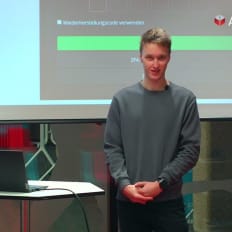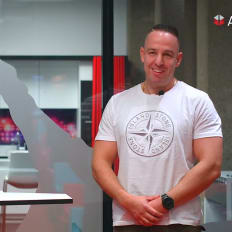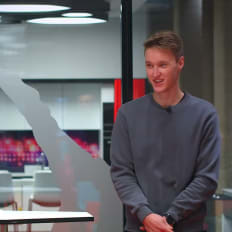
Auftragnehmerkataster Österreich
Patrick Osika, IT-Leiter bei ANKÖ
Description
Patrick Osika von ANKÖ spricht im Interview über den Aufbau des IT Teams im Unternehmen, den Ablauf des Bewerbungsprozesses und gibt Einblicke in die technologischen Challenges.
By playing the video, you agree to data transfer to YouTube and acknowledge the privacy policy.
Video Summary
In "Patrick Osika, IT-Leiter bei ANKÖ," Speaker Patrick Osika describes a 10+ person IT team (two admins, mostly full‑stack developers plus a project lead) that hosts all services in‑house, works agile without strict Scrum, ships short releases, and uses a holistic approach to stay flexible and make the procurement domain efficient and scalable. The culture blends long‑tenured and new colleagues, emphasizes teamwork and mutual support, and is driven by “technicians with heart” passionate about digitalization; the stack is .NET/.NET Core/C# on the backend and Angular on the frontend, with interfaces to national and EU institutions. Hiring starts with HR screening and a first interview with HR and him, followed by a second round with the entire IT team to create a comfort factor and go deeper on skills; they look for team fit and helpfulness, and support talent with a continually refined onboarding plan and a focus on early innovation and portfolio expansion.
Agile engineering with heart: Takeaways from “Patrick Osika, IT-Leiter bei ANKÖ” on team, tech stack, and hiring at Auftragnehmerkataster Österreich
Context: Auftragnehmerkataster Österreich through the lens of engineering
In the session “Patrick Osika, IT-Leiter bei ANKÖ,” Patrick Osika offers a concise yet revealing look into the IT organization of Auftragnehmerkataster Österreich (ANKÖ). The throughline is unmistakable: a team of engineers who “lead with heart,” running everything in-house, working agile without dogma, and shipping in short release cycles to stay close to customer needs. From our DevJobs.at editorial seat, we noted the essentials tech talent care about—team structure, engineering culture, hiring expectations, collaboration practices, and the technology choices that underpin ANKÖ’s mission.
Mission: Efficiency and scalability in public procurement
“Our main tasks lie in the efficiency and scalability of procurement,” Osika says. That mandate drives the organization’s structure, its ways of working, and technology decisions.
“Our main tasks lie in the efficiency and scalability of procurement … [to] make procurement more efficient.”
For engineers, this translates into software with tangible, everyday impact—solutions that customers depend on for functionality, speed, and reliability.
Team structure: More than ten people, one holistic approach
The IT team is “more than ten people,” comprising two administrators, mostly full-stack developers, and a project lead. A deliberate mix stands out: long-tenured colleagues (some with more than a decade at ANKÖ) working shoulder-to-shoulder with newer team members. That blend of experience and fresh perspectives supports both stability and momentum.
- Team size: more than ten people
- Composition: 2 admins, a majority of full-stack developers, plus a project lead
- Tenure mix: long-serving colleagues (10+ years) alongside recent hires
“There are long-serving colleagues who have been with ANKÖ for more than ten years, but also newly added colleagues—and that simply makes a good mix.”
In-house hosting: End-to-end responsibility under one roof
ANKÖ hosts “everything in-house, all our services.” That choice anchors end-to-end ownership—from infrastructure and operations to application development. For engineers, it means proximity to production, fewer handoffs, and accelerated learning loops. When you build and operate the system, the impact of your decisions becomes visible faster and more completely.
“We host everything in-house, all our services.”
The team doesn’t work in isolated silos; it thinks holistically about how backend, frontend, infrastructure, and operations fit together. The unifying question remains: which decisions increase customer efficiency? That shared mindset is actively cultivated.
Ways of working: Agile, pragmatic, and defined by short releases
“We work agile, not so strictly according to Scrum. We take the methods that matter to us.” ANKÖ embraces pragmatic agility: fewer orthodoxy debates, more usefulness. The north star is what helps the team deliver quickly and reliably.
“It’s important that all colleagues know the holistic approach. That simply creates flexibility for us.”
In practice that means “short releases.” They keep the product close to customer needs, maintain continuous feedback, and enable timely reprioritization. Combined with the holistic mindset, ANKÖ is not only responsive to change—it is prepared for it.
- Agile without dogma; methods chosen by need
- Holistic understanding across the team for flexibility
- Short release cycles to address customer wishes fast
“We have short releases. That makes us very flexible regarding our customers, their needs and wishes.”
Engineering culture: People behind the application—technicians with heart
What Osika says about his team resonates: “They are all technicians with heart.” There’s palpable passion for digitalization, and a shared aim: deliver a good product to customers—every day.
“There are people behind the application, and you can feel the passion for digitalization … at the end of the day everyone wants to bring a good product to the customer.”
That ethos is supported by several elements made clear in the session:
- A team that mutualizes support
- Autonomy in methods and release rhythm
- An environment that fosters end-to-end ownership
The result is a culture where quality is not mandated from above—it emerges from intrinsic motivation.
Collaboration: Team-minded and actively supportive
Asked what ANKÖ looks for in candidates, Osika highlights team orientation and a culture of mutual support. Colleagues spend a lot of time together; it should feel constructive and dependable.
“Teamwork … the culture of mutual support … everyone looks out every day to help one another.”
In day-to-day terms, that means shared knowledge, joint problem-solving, and prioritizing team outcomes over individual wins. Coupled with the holistic approach, this elevates systemic understanding—a powerful lever for efficiency and scalability.
Hiring: Two steps, transparent, with full team involvement
Recruiting begins with a joint review of candidates by HR and the IT lead. The first interview involves HR and Osika. If the outcome is positive, there’s a second round—involving the entire IT team by design.
“It’s important to us that in the second round the entire IT team is already involved, to create a feel-good factor. Both sides can get to know each other.”
The aim is to foster comfort and clarity early: Who will I work with? How does collaboration feel? Which skills are particularly relevant? This setup creates symmetry and reduces surprises before day one.
- Round 1: Conversation with HR and the IT lead
- Round 2: Full IT team meets the candidate; deeper discussion of skills
- Emphasis on fit, transparency, and mutual understanding
Onboarding: A plan, feedback after probation, and continuous refinement
ANKÖ has an onboarding plan that was “worked out in recent months.” Just as important is systematic feedback: after the probation period, the team regularly asks what went well and what should change. The process is evaluated continuously, with the goal of integrating each new colleague into ANKÖ’s culture and the IT team.
“We regularly get feedback from candidates after the probation period … we evaluate the entire onboarding process … so that everyone feels well integrated into the ANKÖ culture and into the IT team.”
This marks an organization that iterates not only on software but on its people processes. The parallel between product agility and team agility is unmistakable.
Tech stack: .NET/.NET Core and C# in the backend, Angular in the frontend
Technologically, ANKÖ relies on a clear foundation:
- Backend: .NET, .NET Core, C#
- Frontend: Angular
“Our backend basis is .NET, .NET Core, C-Sharp; our frontend is Angular, and these technologies help us stay flexible and move into the future.”
The rationale is flexibility and future-readiness. This stack allows ANKÖ to steadily expand its product portfolio, including interfaces to national and EU institutions—critical to supporting customers in procurement and making the process more efficient overall.
“We have interfaces to national and EU institutions that support our customers in procurement in their daily work … and make the procurement process more efficient.”
For developers, this means working on APIs and integration points that matter to users every day—a context where technical excellence meets domain relevance.
Releases and customer closeness: Speed with purpose
Short releases at ANKÖ are not an end in themselves; they are the expression of customer proximity. They enable the team to pick up wishes quickly and show impact fast. Combined with in-house hosting, there’s a direct loop of building, operating, feedback, and improvement.
- Iterative delivery over big-bang releases
- Tight alignment with customer needs
- More opportunities to test innovations early
“…very flexible regarding customer needs … at the end of the day everyone wants to bring a good product to the customer.”
Innovation as a posture: Spot early, implement steadily
“What is very important to us is to recognize innovations early and continuously expand our product portfolio.” Innovation at ANKÖ is not a moonshot; it’s a continuous practice—identify early, feed into the roadmap, implement.
“We still have some ideas in the repertoire that we will try to implement in the coming months.”
For tech talent, this means an environment where new ideas—aligned with the mission—aim for impact. The organization and stack support that: short releases, holistic understanding, and direct customer links.
Why ANKÖ stands out to engineers
Several clear reasons emerge from the session as to why developers and admins could thrive at ANKÖ:
- Holistic ownership: If you value end-to-end responsibility—from infrastructure to frontend—this structure supports it.
- Pragmatic agility: Methods by need, outcome focus, short releases.
- Strong team ethos: A “culture of mutual support” and visible passion for digitalization.
- Societal relevance: Software that makes procurement more efficient and connects with national and EU institutions.
- Learning loops via in-house hosting: Proximity to operations, fast feedback cycles, tangible impact.
- Transparent hiring: Early and full-team introductions foster genuine comfort and clarity.
- Thoughtful onboarding: A plan plus post-probation feedback to continuously improve integration.
- Modern stack: .NET/.NET Core, C#, and Angular for robust backends and modern frontends.
Leadership signals: What Patrick Osika underscores
Osika’s remarks paint a coherent picture of an IT leader aligning culture, methods, and technology toward impact:
- Culture: People-centered, supportive, product-oriented.
- Methods: Agile without ideology—“we take the methods that matter to us.”
- Technology: A purposeful stack for flexibility and future readiness.
- Organization: In-house hosting as a lever for responsibility and learning.
- Hiring & onboarding: Team involvement and continuous feedback as default.
These elements mesh together—and help explain why ANKÖ’s IT can respond quickly and deliver reliably.
Quotes to remember
“Technicians with heart.”
“It’s important that all colleagues know the holistic approach.”
“We have short releases … very flexible.”
“In the second round the entire IT team is involved … feel-good factor.”
“We regularly get feedback after the probation period … evaluate the entire onboarding process.”
“Backend: .NET/.NET Core/C#, frontend: Angular.”
“Interfaces to national and EU institutions … making procurement more efficient.”
“Recognize innovations early … continuously expand the product portfolio.”
Everyday collaboration: Holistic thinking as standard practice
The recurring notion of a “holistic approach” is more than a slogan. In practice, it means colleagues understand the systemic impact of their work. For full-stack developers, that’s the blend of frontend and backend perspectives; for admins, it’s close alignment between operations and development. The shared understanding fuels more resilient architecture decisions and reduces friction at handoffs.
- Fewer silos, more ownership
- Decisions across the full lifecycle—from design to operations
- A stronger grasp of user needs
Product proximity: From release to real-world effect
Short releases and customer proximity ensure ANKÖ’s IT can reflect changes in requirements quickly. This setup fits the mission of efficiency and scalability: where processes are complex and external interfaces matter, fast iteration is an advantage—and a hallmark of quality in collaboration.
“… flexible regarding customer needs and wishes.”
Two constants in one team: Stability and renewal
The mix of long-tenured colleagues and new joiners creates a dual strength: experience meets new impulses. For culture, that means best practices are preserved while improvement ideas find open ears. For product development, architecture benefits from seasoned judgment, continually challenged by fresh perspectives.
Candidate journey: From stepping out of the comfort zone to meeting the team
Osika touches a familiar moment: leaving one’s comfort zone to start a new role. The two-step process is built for this. The second round with the entire IT team provides a realistic view—technically and personally. That’s how “fit” becomes a lived alignment rather than a marketing phrase.
“… so that the candidate can get a picture of the team, and colleagues can see who is in front of us.”
Continuous learning: Feedback wired into the process
Not only in software but also in people processes, what is measured and reflected improves. ANKÖ solicits feedback after probation and iterates on the onboarding plan. That reduces friction for new colleagues and strengthens the shared understanding of what matters in the first weeks.
- Regular feedback after probation
- Adjustments to the onboarding plan when useful
- Goal: successful integration into culture and team
Interface competence: Connected nationally and at EU level
A notable trait of ANKÖ’s software environment is its interfaces “to national and EU institutions.” For engineers, this translates into integration work with relevant systems, stable data flows, and robust quality assurance. In a context prioritizing efficiency in procurement, interface competence becomes central to success.
“… supporting our customers in procurement in their daily work.”
Looking ahead: Ideas in the repertoire, implementation in focus
Osika is clear that the roadmap is well stocked: “We still have some ideas in the repertoire … [to] implement in the coming months.” The intent remains consistent: identify early, deliver steadily, work close to user needs. The team has the organizational and technological foundations to do so.
Conclusion: What we learned from “Patrick Osika, IT-Leiter bei ANKÖ”
- ANKÖ’s IT is small enough for quick decisions and large enough for robust ownership—anchored by in-house hosting and a clear tech stack.
- Agility is practiced pragmatically: methods by need, short releases, and a holistic view.
- Culture and recruiting prioritize team-mindedness, support, and transparency—including onboarding with active feedback.
- The mission—efficiency and scalability in procurement—shapes decisions in the stack (.NET/.NET Core, C#, Angular) and the architecture (interfaces to national and EU institutions).
- “Technicians with heart” isn’t a slogan; it’s lived reality: people building software for people, with genuine passion for digitalization.
For tech professionals seeking ownership, product proximity, and strong team spirit, the IT organization at Auftragnehmerkataster Österreich offers a clear proposition: help shape what matters—and ship it regularly.
More Tech Talks
More Dev Stories
Auftragnehmerkataster Österreich Marek Dusecina, Senior Full Stack Engineer bei ANKÖ
Marek Dusecina von ANKÖ erzählt im Interview über seinen Background im Programmieren, gibt Einblicke in seine aktuelle Arbeit im Full Stack Engineering und gibt Tipps für Neueinsteiger.
Watch nowAuftragnehmerkataster Österreich Dominik Zimmel, Product Owner bei ANKÖ
Dominik Zimmel von ANKÖ spricht im Interview über seine Reise bis hin zur Arbeit als Product Owner, wie sein Arbeitsalltag aussieht und gibt nützliche Tipps für Anfänger.
Watch now




